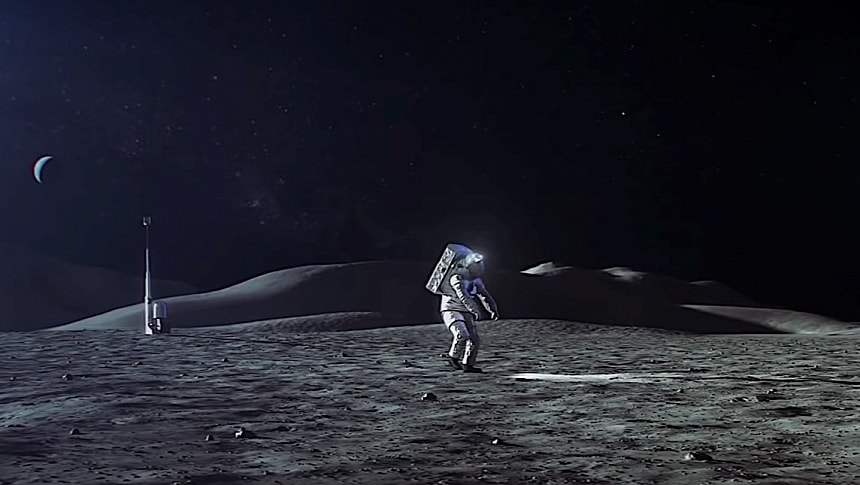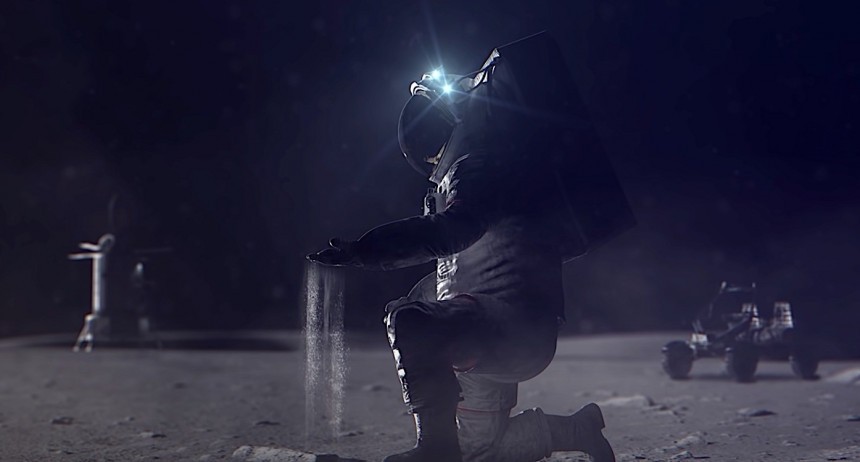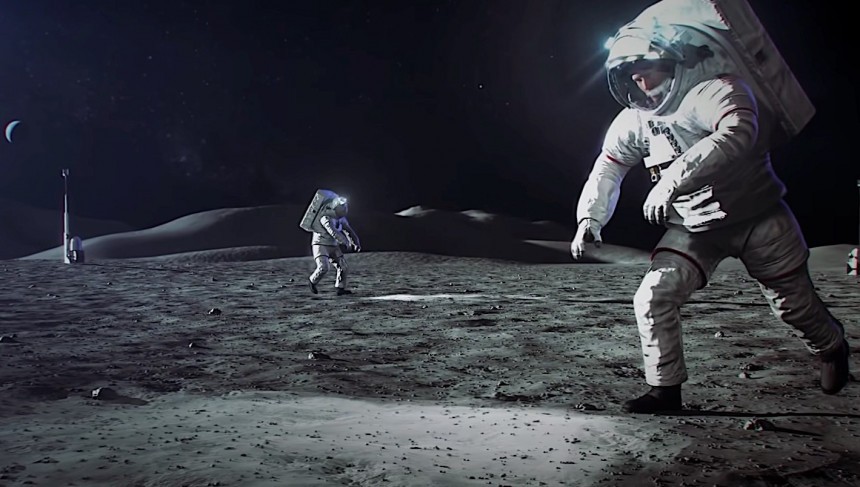The Moon has become the center of attention for pretty much all ongoing space exploration efforts currently taking place on Earth. Naturally, the most visible such efforts have to do with how we'll get there and what we'll do while on site. Yet behind the scenes a lot more (and more exciting) things are happening.
You all know how Earthlings plan to go to the Moon once more, then build a space station in orbit around it, and later build outposts on the surface to further our understanding of the place and kickstart our expansion into the solar system. All that takes a lot of planning and work, but it would all eventually amount to nothing if proper infrastructure is not designed for the satellite.
With that in mind, one of the world's most creative research agencies, DARPA, launched last year an effort called the 10-Year Lunar Architecture (LunA-10) program. In a nutshell, we're talking about research meant to identify the risk and devise the solutions to sustain "a burgeoning cislunar and lunar economy of scientific research and commercial development in the coming decade."
Since its introduction LunA-10 has been in the spotlight several times, most recently thanks to the Honeybee Robotics-devised piece of hardware called Lunarsaber. An acronym for Lunar Utility Navigation with Advanced Remote Sensing and Autonomous Beaming for Energy Redistribution, the tech is more or less a very tall pole (328 feet/100 meters) that will act as a lamp post but also a communications relay and navigation beacon.
Before that we had the Elytra spacecraft design envisioned by Firefly Aerospace to act as docking hubs where spaceships could perform fuel transfer, share power and thermal resources, and deliver or transfer payloads.
And now as part of the same program come Northrop Grumman and its idea of developing a moon-based railroad network that could aid with the transportation of humans, supplies, and resources on the surface of the Moon.
And I have to admit, that's an idea so simple and potentially effective that one wonders why no one has thought about it before.
You see, most of the mobility plans being considered for lunar operations involve wheeled or even tracked vehicles moving around the surface, going from place to place guided by either navigation beacons or satellites. But a railway network would be much easier to implement and use, and would technically need less aiding infrastructure and advanced technologies compared to rovers.
Trains going down the same track day after day would also be easier to use, and they will also be able to carry much more cargo compared to other kinds of vehicles.
As such, under DARPA's guidance, Northrop Grumman took on the task of imagining exactly how such a network would be built and how much effort and resources it would require.
First and foremost the space company and defense contractor will have to "define the interfaces and resources required to build a lunar rail network." It will compile a list of expected costs and risks and only then move on to identifying prototypes and imagining demos and analyses for them.
The final stage of this initial program will look into the specifics of a railway, including "grading and foundation preparation, track placement and alignment, joining and finishing, inspection, maintenance and repair."
What all of the above means is that the project is only getting started, and there are no actual details on either the tracks themselves or the trains that will use them. You do have to keep in mind, though, that the LunA-10 program, of which Northrop Grumman is part, should conclude in about a decade, so we'll likely get more details soon.
LunA-10's main goal is to bundle Moon exploration technologies together in a single scalable package instead of having companies design single systems for single needs. And that means it's likely the train network will incorporate or use technologies developed by others as well.
Not long ago DARPA announced the companies that are taking part in LunA-10. There are in all 14 of them, working to come up with ideas in the field of lunar transit and mobility, energy, communications, and infrastructure.
The list includes many space startups but also crews that have established themselves as pillars of the revived space industry, including NASA partners Blue Origin and SpaceX.
DARPA warns though that any ideas born in the LunA-10 will not be funded by the agency to be brought into the real world, nor will it back the technologies' transportation to the Moon and their integration with lunar delivery vehicles.
What the agency says it does is help its partners with economic expertise and analysis. There is some money involved, naturally, in the form of at most $1 million offered as Other Transaction awards to selected white papers.
We'll keep an eye out for what the other companies involved have up their sleeve, as we're sure to get some truly wacky ideas for the Moon in the coming months.
With that in mind, one of the world's most creative research agencies, DARPA, launched last year an effort called the 10-Year Lunar Architecture (LunA-10) program. In a nutshell, we're talking about research meant to identify the risk and devise the solutions to sustain "a burgeoning cislunar and lunar economy of scientific research and commercial development in the coming decade."
Since its introduction LunA-10 has been in the spotlight several times, most recently thanks to the Honeybee Robotics-devised piece of hardware called Lunarsaber. An acronym for Lunar Utility Navigation with Advanced Remote Sensing and Autonomous Beaming for Energy Redistribution, the tech is more or less a very tall pole (328 feet/100 meters) that will act as a lamp post but also a communications relay and navigation beacon.
Before that we had the Elytra spacecraft design envisioned by Firefly Aerospace to act as docking hubs where spaceships could perform fuel transfer, share power and thermal resources, and deliver or transfer payloads.
And now as part of the same program come Northrop Grumman and its idea of developing a moon-based railroad network that could aid with the transportation of humans, supplies, and resources on the surface of the Moon.
And I have to admit, that's an idea so simple and potentially effective that one wonders why no one has thought about it before.
Trains going down the same track day after day would also be easier to use, and they will also be able to carry much more cargo compared to other kinds of vehicles.
As such, under DARPA's guidance, Northrop Grumman took on the task of imagining exactly how such a network would be built and how much effort and resources it would require.
First and foremost the space company and defense contractor will have to "define the interfaces and resources required to build a lunar rail network." It will compile a list of expected costs and risks and only then move on to identifying prototypes and imagining demos and analyses for them.
The final stage of this initial program will look into the specifics of a railway, including "grading and foundation preparation, track placement and alignment, joining and finishing, inspection, maintenance and repair."
What all of the above means is that the project is only getting started, and there are no actual details on either the tracks themselves or the trains that will use them. You do have to keep in mind, though, that the LunA-10 program, of which Northrop Grumman is part, should conclude in about a decade, so we'll likely get more details soon.
Not long ago DARPA announced the companies that are taking part in LunA-10. There are in all 14 of them, working to come up with ideas in the field of lunar transit and mobility, energy, communications, and infrastructure.
The list includes many space startups but also crews that have established themselves as pillars of the revived space industry, including NASA partners Blue Origin and SpaceX.
DARPA warns though that any ideas born in the LunA-10 will not be funded by the agency to be brought into the real world, nor will it back the technologies' transportation to the Moon and their integration with lunar delivery vehicles.
What the agency says it does is help its partners with economic expertise and analysis. There is some money involved, naturally, in the form of at most $1 million offered as Other Transaction awards to selected white papers.
We'll keep an eye out for what the other companies involved have up their sleeve, as we're sure to get some truly wacky ideas for the Moon in the coming months.
















